 The author’s two PAR meters. On the left, a Li-Cor Model LI-189; on the right, an Apogee Instruments’ Model QMSW-SS (with optional BNC connector). Both show wear and tear from years of use, but have held up remarkably well. The black threaded fitting below the Apogee meter is part of a homemade underwater housing.
The author’s two PAR meters. On the left, a Li-Cor Model LI-189; on the right, an Apogee Instruments’ Model QMSW-SS (with optional BNC connector). Both show wear and tear from years of use, but have held up remarkably well. The black threaded fitting below the Apogee meter is part of a homemade underwater housing.
I began the research for this article in 1999 and only recently have had the time and interest to complete a comparison of my two quantum meters – One made by Li-Cor, Inc.; the other by Apogee Instruments. This comparison includes measurements made across a wide range of light intensities and spectral qualities (4,000 – 20,000 K metal halide lamps). This particular Apogee meter has a switch for alternation
between measurements of ‘Sunlight’ and ‘Electric Lamps’, and I can make some casual recommendations for which
to use with particular metal halide lamps.
This article is also in response to various challenges made to the validity of PAR measurements made with Apogee Instruments’ relatively inexpensive meter. (For those with an inclination to read these debates, see Advanced Aquarist’s ‘Forums’ section for comments about Mike Kirda’s article “Light in the Reef Tank: Some Real Data” and an article by Miguel Olaizola and myself entitled “Lighting the Reef Aquarium: Spectrum or Intensity” – Advanced Aquarist Online – Volume 2, Number 8, and Volume 1, Number 2, respectively).
PAR meters (also called quantum meters) are the preferred instruments for measuring light intensity when photosynthesis is involved. Ideally, quantum meters measure (and report as equal) the amount of energy in light wavelengths between 400nm and 700 nm, and report it in units of micromol per square meter per second (µmol·m²·sec). Full intensity sunlight is generally ~2,000 µmol·m²·sec. ‘Micromol’ is the preferred unit for reporting purposes, as opposed to ‘microEinstein’, a unit that is commonly used in older literature. However, any measure of PAR or PPFD (either µmol·m²·sec or µE·m²·sec) are still somewhat of ‘outlaw’ units, not recognized as SI units, and something of buzzwords to those obsessed with botany or phycology.
However, the Li-Cor series of quantum meters has been the
standard for use in measuring photosynthetically active radiation
for a number of years. If price is indeed equal to quality and
accuracy of light measurements, then the Li-Cor meter will beat
most any other competitor. But does ‘price’ equal
‘right’?
Perhaps we should examine each meter’s features before we get into the comparative data. Let’s begin with:
Sensor Design
On the face of it, sensors are simply light-measuring
photodiodes within protective housings. Their jobs are relatively
simple – collect light energy (photons) and convert it to
measurable current (electrons), and as long as the sensor’s
housing is waterproof, it would seem that all sensors are pretty
much equal. Not so.
Collector Design: 2 pi v. 4 pi
One of the first considerations is the ‘type’ of light
you’ll want to measure. For our purposes, there are two sorts
of light – downwelling (such as that emitted from the sun or an
artificial source) and upwelling (such as that light reflected
from a white sand bottom, live rock, etc.). Unless you are
growing phytoplankton (which can collect light from all sides),
you’ll probably want to obtain a sensor that measures only
downwelling light. This is called a 2 pi sensor, and is
the type used for the measurements reported in this article.
Li-Cor offers a 4 pi sensor (Model Li-193SA) which
resembles a standard frosted light bulb in appearance – it
measures up-welling and down-welling light. Upwelling
light can contribute a significant amount to the total amount of
light. This should not be a concern with corals. If one wishes to
measure upwelling light, simply point the sensor toward the
bottom of the tank to get an estimate of reflected light.
According to the measurements made by my mentor in lighting (Pete
Mohan, then of Sea World Ohio), there is not a deal of difference
in measurements made in aquaria by 2 pi and 4
pi sensors.
Spectral Response
Spectral response has been the loudest argument used in
debates of comparing measurements between brands of quantum
meters. A quantum meter sensor’s ideal spectrum response
would report as equal the energy in each wavelength between
exactly 400nm and 700nm. However, neither the Li-Cor nor the
Apogee response is ideal. The Apogee underreports blue
wavelengths more so than the Li-Cor. The cutoff in the red
portion of the spectrum is at ~650nm for the Apogee; the Li-Cor
sensor extends its range (albeit slightly) into the near-infrared
(cutoff at 700nm, but with a slight response to ~720nm). Near-IR
radiation can cause substantial errors in certain cases.
Apogee maintains in their advertisements that most lamps’
spectral qualities will negate any ‘deficiencies’ in
their sensors’ responses. We’ll later see if this claim
is valid!
Cosine Collector and Correction
Both Apogee and Li-Cor sensors are cosine corrected to 80 degree
angle of incidence. In plain English this means that the sensors
can detect radiation coming into the sensor at angles of up to
80 degree from the center of the sensor ‘window’ or diffuser.
Sensors without cosine correction will not accurately report
intensities of diffused light (such as that of cloudy days, low
sun angles, from fluorescent lamps). The Li-Cor Instruction
Manual states that cosine correction overcompensates in air and
under-compensates in water.
Sensor Construction and Photodiode Type
The Li-Cor sensor is robust, with the housing being made of
copper alloy. There is a diffuser of white acrylic protecting
internal filters and a silicon-based and blue-enhanced
photodiode. These filters and diffuser are long lived. I had my
LI-192SA sensor rebuilt after 9 years of heavy use (and 50,000
measurements). The rebuild was necessary due to ‘fogging’
of the acrylic diffuser.
The Apogee sensor is much smaller than the Li-Cor, and is made
of plastic (both a plus in closed system aquaria with strong
coral growth). It is 24mm in diameter and 25mm tall. The
photodiode is made of gallium arsenide.
Immersion Effect
The Immersion Effect refers to light loss caused by different
refractive indices of air and water – there is less internal
reflection of light within an immersed sensor. Li-Cor quantum
meters have a water calibration factor in order to overcome this
loss. Apogee’s meters do not offer such an option.
And while on the subject of immersion, one should be concerned
about the water resistance of the submersible sensors. Li-Cor
advertises a pressure rating of the 2 pi LI-192SA
Underwater Sensor as 800 psi (54 bars); The 4 pi
Spherical LI-193SA is rated for 500 psi (34 bars). Apogee does
not advertise a pressure rating, but I can speak from personal
experience that their sensor is waterproof to depths of 37 meters
(~120 feet) during SCUBA dives (the meter itself is in a
waterproof housing). Suffice it to say that I doubt if either of
these sensors will ever fail in even the deepest aquarium!
Effects of Temperature
Temperature affects meter performance and sensor response.
Apogee advertises their instruments to perform in temperatures of
up to 50 degree C (depending upon non-condensing relative humidity);
Li-Cor advertises their meters to withstand temperatures of up to
55 degree C and 90% RH (non-condensing) are appropriate for proper
operation.
Instrument Range and Resolution
The Apogee quantum meter reports up to 1,999
µmol·m²·sec (in increments of 1 µmol·m²·sec),
while the Li-Cor reports on the order of a magnitude higher –
19,999 µmol·m²·sec, with resolution ranging from 0.01
µmol·m²·sec to 1 µmol·m²·sec, depending upon
light intensity. It is possible for high wattage metal halide
lamps to produce more radiation than the Apogee meter is capable
of reporting. There are some options – one being use of a neutral
density filter to attenuate the amount of light entering the
sensor. A cheaper (and perhaps more convenient way) is to use a
small piece of non-metallic window screen. Compare readings in a
lower light environment to arrive at the appropriate correction
factor for use in extreme light conditions. It is also possible
to max out the Li-Cor meter – we managed to do that while
beta-testing a 1,000 watt Fusion sulfur lamp a few years ago.
Portability and Battery Life
Both brands of quantum meters are light weight and easily
portable. They use one standard 9v battery, and battery life is
excellent (100-200 hours). A ‘low battery’ warning is
standard on both meters.
Periodic Factory Calibration
Sensor response drifts as a result of use more than time
(according to Apogee). However, both meters should be
periodically recalibrated by the factory. Li-Cor recommends
recalibration every 2 years (and charges $75 for the service).
Apogee charges $40, but instead of recommending a recalibration
period etched in stone, they offer this neat trick for meters
with ‘average’ aquarium use: Get a new frosted,
incandescent light bulb. Measure the output of this lamp in a
dark room, record the results and store the bulb. Measure the
lamp output (under standardized conditions) once a year. Return
the quantum meter when results are subjectively unacceptable.
In my case, I have the luxury of comparing the Apogee
sensor’s response to that of the Li-Cor (which is factory
recalibrated every two years). The Apogee hasn’t been
calibrated since purchase.
Price
Apogee has cut production costs by utilizing a number of
measures – the meter’s plastic housing is not as heavy-duty
as the Li-Cor’s. (My first, and incorrect, impression of the
Apogee meter was ‘toy-like.’) Battery replacement for the
Apogee involves removing two small screws in order to separate
the halves of the housing; Li-Cor has a convenient sliding
battery hatch. As an aside, the ability to report intensities
greater than 1,999 µmol·m²·sec, would be a plus. The
sensors also differ. The Apogee contains a less expensive gallium
photosensor, and the sensor housing is small and made of plastic
(actually an advantage in cramped aquaria).
The Apogee Model QMSW-SS retails for $298.00, plus tax and
shipping. I had Apogee build my meter with an option BNC
connector, so I could remove the 2 meter cable and sensor for
storage. This option was $20 in 1999.
I paid $1,100 for the Li-Cor LI-189 quantum meter, underwater
cable (3 meters in length), LI-192SA sensor, and nylon carrying
case in 1995.
There are obviously major differences between the two meters
in construction. But what about the quality of the actual light
measurements? Are they comparable?
A comparison of measurements was made using 5 metal halide
lamps ranging in advertised Kelvin ratings of 4,000 to 20,000.
This is how it was done:
Procedure
The comparison protocol was quite simple – a jig was made of
degree ” PVC pipe, fittings and acrylic. Rubber bands held the
sensors closely together and helped maintain matching vertical
and horizontal orientations. The sensors’ cables were
attached to the PVC pipe with white nylon cable ties (See Figure
2). In this manner, simultaneous measurements could be made
without worry of error due to fluctuating line voltage and
brightening/dimming of the lamps’ outputs.
A white plastic bucket was filled with tap water which allowed
an effective depth of ~18cm for the immersed sensors during the
water comparisons. The PVC pipe created remarkably little water
surface agitation; however, the water was given a few seconds to
‘flatten’ before measurements were recorded.
To avoid a major source of error, the sensors were placed
parallel to the long axis of the lamps’ arc tube. In this
manner, I could minimize the effects of light distribution and
resulting radiation gradients. However, the sensors were moved
slightly during the course of taking each measurement to
determine if gradients were present – No drastic shifts in light
intensity were seen.
The Li-Cor meter has calibrations points for ‘air’ and
‘water’ measurements, and the meter was calibrated
accordingly. Factory recalibration of the meter, along with
sensor rebuild, was performed in November, 2004 – well within the
recommended two-year recalibration period
Water and sensor temperatures were monitored with a
non-contact, infrared thermometer during testing. Temperatures
ranged from 26.6 to 28.3 degree C (well below the maximum temperature
ratings of either sensor).
Figure 2. A literal side-by-side comparison
of quantum meter sensor responses. The sensor diffusers are 25
mm apart. See text for details of test protocols.
Results
The PAR of 5 metal halide lamps was measured with the Li-Cor
meter (appropriately calibrated for ‘air’ or
‘water’) and the Apogee (switched between
‘Sunlight’ and ‘Electric Lamp’ measurements).
I didn’t spend a lot of time investigating how the two
brands of sensors respond to light measurements made in air.
However, Figures 3 and 4 demonstrate that the two sensors compare
favorably under conditions of different spectral quality and
intensity in air. But how do the underwater measurements of the
two meters compare? We’ll compare results of individual
lamps, and then summarize the findings ‘In Closing’.
Figure 3
Figure 4
Underwater Measurements – Philips 4,000K Metal Halide
Lamp
Figures 5 and 6 show the response of this lamp (which happens
to be the exact lamp used in the PAM experiments reported in the
February 2002 Advanced Aquarist. The results of the Aquarium
Lighting System – ALS – 12,000K lamp are reported below. This too
is the same exact lamp used in the referenced PAM experiments.
Both of these lamps have been in storage, and unused, since those
experiments).
Figure 5
Figure 6
Underwater Measurements – Iwasaki 6,500K Metal Halide
Lamp
Figures 7 and 8 chart the two sensors’ responses for a
perennial favorite – the Iwasaki 6,500K ‘Daylight’
Lamp.
Figure 7
Figure 8
Underwater Measurements – Ushio (aka AB/Hamilton) Metal
Halide Lamp
The German-made Ushio lamp has been marketed under a number of
private labels, and has earned a reputation of quality and
reliability. I use the label name of ‘AB 10000K’ and
report the results in Figures 9 and 10.
Figure 9
Figure 10
Underwater Measurements – ALS 12,000K Metal Halide Lamp
As mentioned earlier, this is the exact lamp used in the PAM
fluorometer article in Advanced Aquarist’s February 2002
issue. It has been archived since use in that experiment.
Figure 11
Figure 12
Underwater Measurements – Coralife 20,000K Metal Halide
Lamp
I used this lamp for several reasons. Judged visually, it is
the ‘bluest’ metal halide lamp I have in my collection.
It has some use on it, and since it is used, represents a blue
lamp of depreciated spectral quality. In other words, this lamp
is representative of ‘real life’ situations.
Theoretically, we should see the largest discrepancies between
the competitors in an almost monochromatic blue light source.
Incidentally, this is the ‘old style’ Coralife lamp,
which was replaced by another model about 5 years ago. See
Figures 13 and 14.
Figure 13
Figure 14
In Closing
The Apogee quantum meter’s measurements were surprisingly
close to those obtained with the Li-Cor meter. More surprisingly
was that (except for the Philips 4,000K lamp) the Apogee’s
measurements were in best agreement with those of the
Li-Cor’s when in the ‘Sunlight’ calibration mode.
Table 1
| Sunlight Calibration | Electric Lamp Calibration | |
|---|---|---|
| 4,000K | X | |
| 6,500K | X | |
| 10,000K | X | |
| 12,000K | X | |
| 20,000K | X |
The actual degree of error between measurements obtained with
the two brands of sensors is difficult to describe. Based simply
on percent error, these can be misleading, as intensity plays an
important part. That is, at low light intensities, a minor
difference of even 1 µmol·m²·sec can equate to a profound
percentile difference. On the other hand, the difference between
actual measurements generally increases with light
intensity (and the percent difference generally
decreases). It is tempting to describe an average range of light
intensity found in aquaria, but this exercise is ultimately an
exercise of futility. For this reason, Table 2 reports the
average percent difference across the entire range of
PAR measurements.
Table 2
This Table shows the percent difference between the
Apogee’s 2 light measurements in its 2 calibration modes when
compared to those measurements obtained with the Li-Cor
instrument. Generally, the Apogee’s readings were lower than
the Li-Cor’s, except for high readings of the Philips 4000K
lamp (Sunlight Calibration), and mixed readings (higher
and lower, Sunlight Calibration) with the AB
(Ushio/Hamilton) 10000K lamp.
| Sunlight Calibration | Electric Lamp Calibration | |
|---|---|---|
| 4,000K | 8.25% High | 1.94% Low |
| 6,500K | 1.6% Low | 11.0% Low |
| 10,000K | 0.36%* | 9.3% Low |
| 12,000K | 3.9% Low | 7.8% Low |
| 20,000K | 7.3% Low | 12.0% Low |
*Yes, 0.36%, based on measurements that were slightly higher,
and slightly lower, across a broad range of intensity than those
reported by the Li-Cor LI-189 meter. As expected, the difference
in readings was greatest in the almost monochromatic 20,000K
lamp.
In my opinion, objections to the validity of the Apogee’s
measurements based strictly on the issue of spectral response are
unjustly founded. The largest source of error lies squarely (but
potentially) with the user of the instrument, and not inherent
optical qualities. User error includes sensor orientation, sensor
cleanliness, instrument condition (care, maintenance,
calibration) etc.
It would seem that any reports of PAR and PPFD measurements
should include the instrument’s last calibration date or at
least a report of deviation from a standard light source or
calibrated quantum meter.
Footnotes
The Li-Cor quantum meter LI-189 has been replaced with a newer
model, the LI-250A. I would expect Li-Cor’s same high quality
is present in this newer version. The LI-250A includes an ability
to toggle between ‘air’ and ‘water’ calibrations
with the simple push of switch.
Apogee has upgraded its sensor to include a self-cleaning
dome, which also assists in cosine correction. I have been
informed (personal communication with Shaun, Apogee Instruments)
that they are working on improving the spectral response of their
photodiodes.
One may wonder why I have purchased two quantum meters – the
Apogee meter was obtained for use in some of the early
respirometer work, since its sensor is more compact than that of
the Li-Cor, and is especially of use in tight or cramped spots.
Later, the Apogee meter would be used for investigative light
measurements on Hawaiian reefs. It is inexpensive enough to
consider an expendable item should I ever flood my homemade
underwater housing.
For further information, see these websites:
- Joe Burger’s Cnidarian Reef:
http://www.cnidarianreef.com/lamps.cfm - Apogee Instruments:
http://www.apogee-inst.com - LI-COR, Inc.:
http://www.licor.com
References
- LI-COR, Inc., 1990. LI-189
Quantum/Radiometer/Photometer Operating Manual.
Publication Number 9003-61. Lincoln, Nebraska. 18 pp. - LI-COR, Inc., 1990. LI-COR Underwater Radiation
Sensors, Type SA Instruction Manual. Publication Number
8609-57. Lincoln, Nebraska. 23 pp. - Kirk, J.T.O., 1994. Light and Photosynthesis in Aquatic
Ecosystems. Cambridge University Press, Canberra. 509
pp.



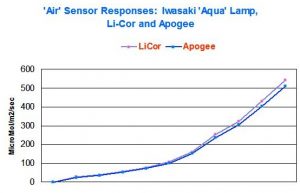
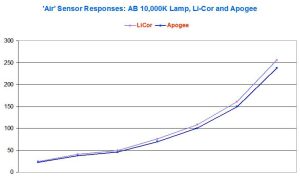
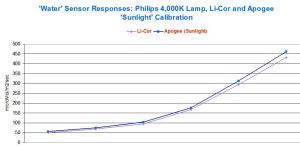

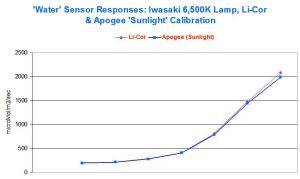
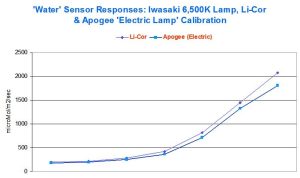
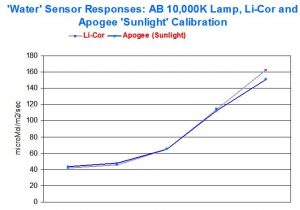
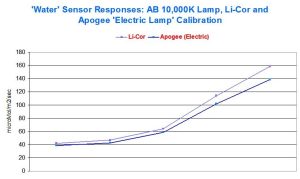
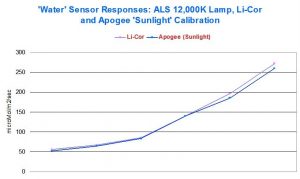
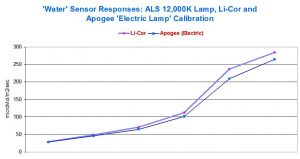
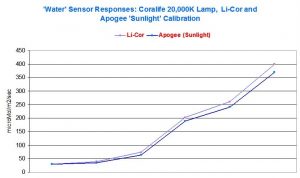


0 Comments